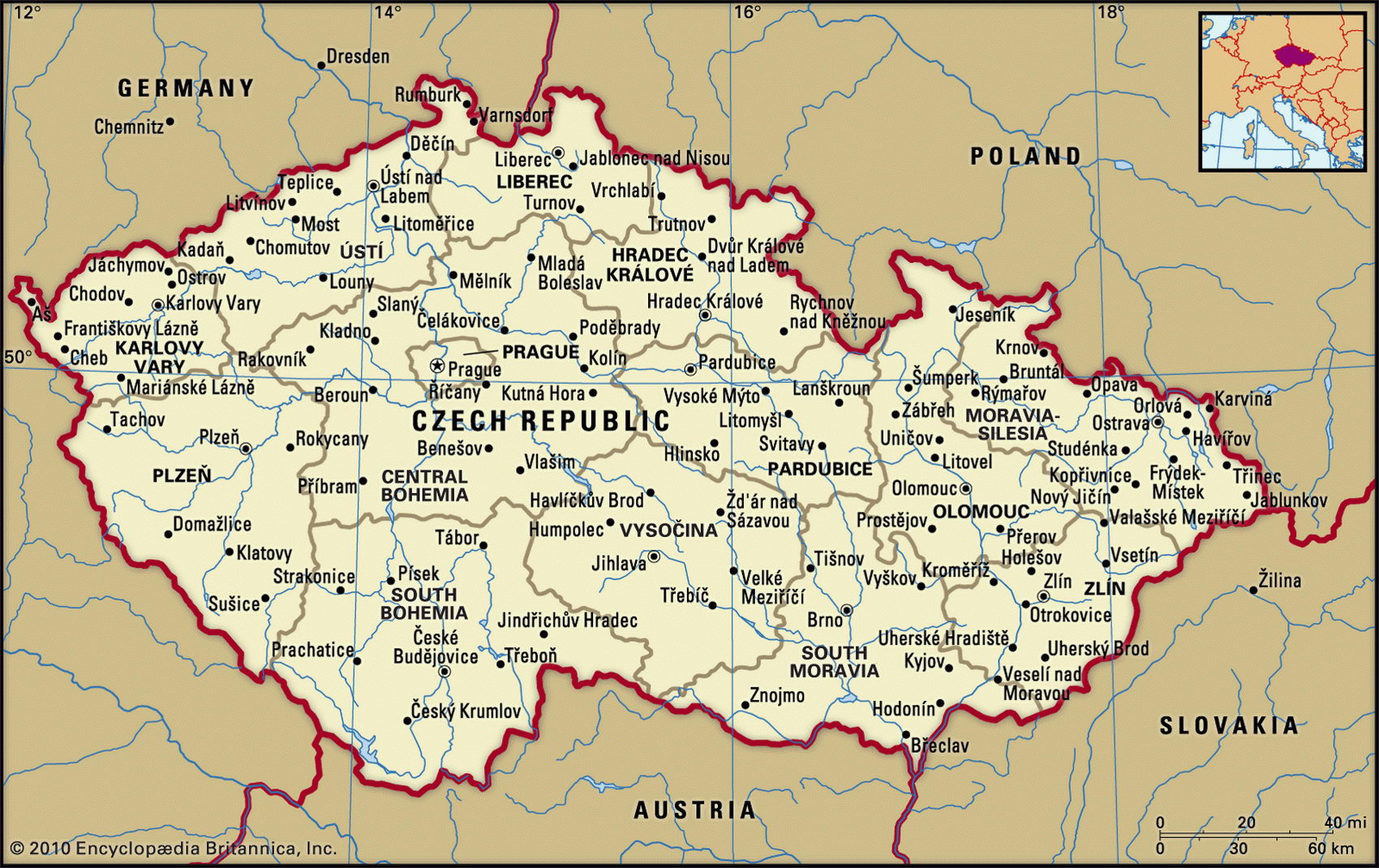Map of Czech Republic and geographical facts
Czech Republic on the world map. Map of Czech Republic
Map of Czech Republic with cities. Where Czech Republic is on the world map. The main geographical facts about Czech Republic - population, country area, capital, official language, religions, industry and culture.

Fact File Czech Republic
Official name Czech Republic
Form of government Republic with two legislative bodies (Senate and Chamber of Deputies)
Capital Prague
Area 78,703 sq km (30,387 sq miles)
Time zone GMT + 1 hour
Population 10,257,000
Projected population 2015 10,028,000
Population density 130.3 per sq km (337.5 per sq mile)
Life expectancy 75.0
Infant mortality (per 1,000) 5.5
Official language Czech
Other language Slovak, German, Polish
Literacy rate 99.9%
Religions Roman Catholic 39.2%, Protestant 4.6%, Orthodox 3%, non-denominational 39.1 %, other 13.4%
Ethnic groups Czech 94.4%, Slovak 3%, Polish 0.6%, German 0.5%, Gypsy 0.3%, Hungarian 0.2%, other 1 %
Currency Koruna
Economy Industry 47 %, services 45 %, agriculture 8 %
GNP per capita US$ 15,300
Climate Temperate, with cold winters and mild, wet summers
Highest point Mt Snezka 1,602 m (5,256 ft) Map reference Pages 288-89
The Bohemian city ofCesky Krumlov in the Czech Republic (right). The city of TrenCin in Slovakia (right page top).
Alandlocked country in Central Europe, until 1993 the Czech Republic was linked to Slovakia, its neighbor to the southeast, from which it is separated by the Carpathian Mountains. The Czech Republic consists mainly of the ancient provinces of Bohemia in the west and Moravia in the east as well as part of the province of Silesia, but most of it now forms a portion of Poland.
Czechoslovakia came into existence in 1918 with the collapse of the Austro-Hungarian Empire at the close of the First World War. The Czechs and the Slovaks had been under one rule since 1471, and since 1526 had been under Austrian domination. Germany occupied Czech territory in 1939, establishing a protectorate of Bohemia-Moravia and setting up a separate state in Slovakia. In 1948 the communists came to power and the country, once again united, came under Soviet influence. Nationalist fervor was never far below the surface and in 1968 caused a movement for democracy. The "Prague Spring," led by Alexander Dubcek, was put down by an invasion of Soviet forces. In 1989 a popular movement led to a transition to a democratic state. Tensions between Czechs and the minority Slovaks led to a peaceful separation of the two states on 1 January 1993.
Bohemia consists largely of gentle hills and plateaus. Low ranges of mountains surround the province to the north, west, and south and the central plateau is traversed by the Elbe and Vltava Rivers, which merge and flow into Germany. Most of the country's agriculture is centered on this river system and much of its produce, including wheat, barley, and potatoes, is transported along these waterways. Bohemia and Moravia are separated by a plateau known as the Moravian Heights. While Moravia is hillier than Bohemia, the center of the province, around Brno, consists of an extensive low plain. Winters are colder and rainfall is heavier in Moravia than in Bohemia. Although not richly endowed with natural resources, reserves of black coal and iron ore have aided the development of iron and steelmaking as the country's major industries. Other important industries include clothing and car manufacture. Bohemian glass is famous worldwide. Industrial production, however, has fallen in the 1990s as the country moves toward a free market economy. Tourism has made up for some of this fall-off.
Czech conflict
The country formerly known as Czechoslovakia was at the center of successive conflicts in the twentieth century. It contains a volatile mixture of ethnic and political differences, and in the past fell victim to German and Soviet totalitarian regimes. Hitler used the disaffection of the German minority in the Sudetenland as an excuse for invading Czechoslovakia in 1938. An insecure period of democracy after 1945 (marred by the expulsion of the still-resident German population) was followed by a communist takeover under Soviet auspices in 1948. In 1968 an effort to democratize the system led by Alexander Dubcek was crushed by Soviet tanks. Along with other parts of Eastern Europe it won independence from communist control in 1989, and since 2004 has been a member of the EU—but these developments have been accompanied by the rise of ethnic separatism, and claims by former German citizens for restitution of property seized at the time of their expulsion after the Second World War. On 1 January 1993 the Czechs separated from the Slovaks in the "velvet divorce", and two republics—the Czech "western" and the Slovak "eastern"—came into existence. Under the presidency of the internationally renowned playwright Vaclav Havel (1993-2003), a wholesale dismantling of state economic controls and structures then took place. However, the government which undertook these extensive reforms collapsed amid scandal and economic chaos at the end of 1997.